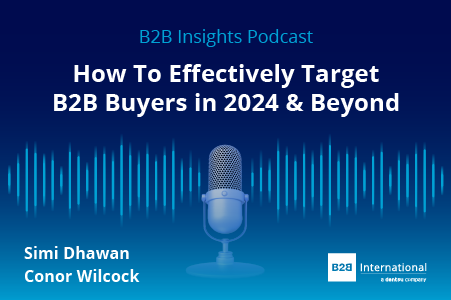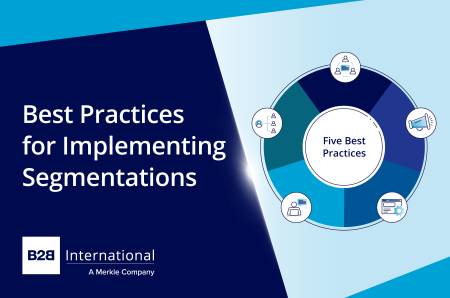The B2B Insights Podcast Channel was created to help marketing and insights professionals navigate the rapidly-changing world of B2B markets and develop the strategies that will propel their brand to the top.
Subscribe today for your dose of exclusive insights from the B2B market experts.

In this episode of the B2B Insights Podcast, B2B International’s Conor Wilcock and Simi Dhawan discuss the challenges marketers face when targeting B2B buyers and how they can use segmentation to overcome these challenges.
Key discussion points:
- The complexity of customer needs and the competitive landscape
- The importance of differentiation in B2B
- Personalization of buyer experiences
- Challenges with data privacy
- How to conduct and use customer segmentation
- Benefits, risks, and pitfalls of segmentation
- How to make segmentation actionable through creative outputs
Listen to the full episode:
Listen on Spotify >
Listen on Apple Podcasts >
Watch the full video:
Read the full transcript:
Jump to section:
- Main challenges facing marketers
- How marketers can effectively market to their audiences
- Benefits of implementing a segmentation strategy
- Risks and pitfalls with segmentation
- Key trends and considerations for successful segmentation projects
Conor: Hello and welcome to the B2B Insights Podcast. I’m Conor Wilcock, Managing Director at B2B International, and I’m joined by Simi Dhawan, Senior Research Director, for an important discussion on the challenges marketers face when targeting B2B buyers and some of the things they can think about to overcome these challenges.
This is particularly important for B2B companies who need to engage a varied customer base with complex needs, whilst at the same time balancing tighter marketing budgets.
In this episode, we’ll explore this challenge alongside delving into segmentation as an important opportunity to effectively target B2B customers.
Main challenges facing marketers
Conor: To start things off, Simi, what would you say are the main challenges marketeers need to keep in mind, based on your experience?
Simi: You mentioned it earlier but marketers have been experiencing tighter budgets since the pandemic and we expect this trend to continue. However, there’s a dichotomy here between tighter budgets, alongside more complex customer needs, expectations and buying decisions, as well as more competition. Brands therefore have to work harder to stand out.
Conor: That’s my experience too and our recent Superpowers data certainly backs this up. Would you agree?
Simi: Definitely…. there’s a number of trends we’ve observed within this wave of Superpowers that suggest that marketers have an increased challenge in making their brand stand out. Our latest wave of Superpowers speaking to over 14,000 B2B buyers globally since 2021 has shown there’s more decision-makers involved in B2B purchasing decisions than ever before – over 7 on average, where this is growing by roughly 6% every year. B2B organizations can’t rest on their laurels since there’s also more brands being considered.
Conor: I’d agree, it’s been quite telling to see that even a third of incumbents have been losing out to other brands which is higher than we observed last year! So, marketers certainly have to work harder than ever to win against the competition.
Simi: I’d go even further and say that they probably think they are doing a better job to stand out from the crowd than they are since we found that 7 in 10 felt they were communicating a distinct USP and brand position whilst 7 in 10 buyers actually felt that B2B brands ‘..have very similar messages’ and ‘all sound and act the same’.
How marketers can effectively market to their audiences
Simi: I suppose the key question then is what is it that marketers can do to more effectively market to their audiences and stand out from the crowd?
Conor: That’s the key question! I suppose what we’ve seen is the power of personalizing experiences and marketing efforts to the needs of buyers.
Whilst on the one hand, it makes sense for marketers to place focus on the aggregate needs of the organization, increasingly, we are finding that the needs of the individual are key and as you mentioned earlier, there are more buyers that are involved in decision-making, so it’s being able to talk to the needs of buyers at different levels – from the senior decision-makers right through to those in more junior or influencer roles.
Marketers should really be demonstrating they understand the day-to-day working world and challenges of these individual buyers. They need to show that they are willing to tailor their offering to fit their needs.
Simi: I think that’s really at the heart of everything we’ve seen and when B2B brands do deliver more personalized brand experiences, they are able to reap the benefits.
On this topic, I’d read something interesting* which said that traditionally, buyers would be happy to share their personal details in exchange for more personalized marketer’s content. However, with increasing concerns about data privacy, fewer buyers are willing to part with this information before they are doing business with a company. What would you say to marketers facing this challenge?
*https://business.linkedin.com/marketing-solutions/technology-marketing/tech-insights/the-rise-of-self-personalised-buyer-journeys
Conor: I think brands can have a human face and offer more tailored experiences without expecting customers to part with personal information upfront.
One effective means is through creating a customer segmentation. With this approach, marketers can seek to better understand their diverse range of customers and use this insight to replace a ‘one size fits all’ marketing strategy into one which is more tailored. Segmentation allows B2B marketers to group customers into ‘like’ segments, for example, because they have similar needs, behaviors, attitudes, firmographics or indeed a combination of these.
This means they can create more targeted value propositions and messaging for each segment they wish to serve, whilst also identifying which segments might be less attractive or aligned to their offer. All of this helps to drive efficiencies in their marketing efforts and resources, which in view of marketing budgets being squeezed, can only be a good thing!
Simi: I think it’s interesting because whilst we are discussing business-to-business, we’re also focused on a more personalized approach for individuals – all of which have their expectations set at what they might experience elsewhere in their consumer lives too.
For example, if we think about subscriptions such as Netflix, we can see personalization at play with personalized content recommendations based on analyzing user behavior. Similarly, B2B brands are adopting a similar approach and an example we’ve seen from our recent Superpowers research is HP, who have been successfully running account-based marketing campaigns that help their sales and marketing teams to understand their target customers better, communicate the right messages to them and connect with them better on both a functional and emotional level.
Benefits of implementing a segmentation strategy
Simi: I think risk and reward are two sides of the same coin, so it would be helpful to explore both for a more balanced discussion for our listeners. Focusing on the reward first, how would you summarize the benefits of implementing a segmentation strategy?
Conor: Well, you could treat all customers the same as a segment of one and try to market in the same way to everyone, but this could result in a business being too generalist in its offerings and marcomms and could be detrimental because it doesn’t demonstrate the tailored approach that B2B business buyers value.
On the flip side, in a perfect world, we could argue that every customer has unique needs and so we should be treating each customer as its own segment, however, this is impractical and inefficient to deliver in practice so we need an approach that is effective and practical. Segmentation is that compromise. It’s a tailored approach to marketing rather than a one size fits all and as we know a more personalized experience can drive commercial benefits.
Simi: What sorts of commercial benefits can be achieved by tailoring a marketing approach in this way?
Conor: We’ve observed that B2B businesses that adopt more personalized experiences can enjoy winning in contracts of higher value, shorter sales cycles and obtaining higher loyalty levels from their customers. However, as our recent Superpowers research demonstrated, only 5% of B2B experiences are delivering fully on this, so there’s an opportunity here.
Risks and pitfalls with segmentation
Conor: You mentioned risk versus reward earlier, so whilst there’s clear benefits to segmentation, what would you say are some of the possible pitfalls to be aware of?
Simi: First and foremost, I think it’s important to identify your business goal for running a segmentation. If your goal is to better understand your existing customer base, which segments are most attractive to focus attention on or increase your sales or loyalty levels amongst these, then it makes sense to run a segmentation project focused on speaking to your existing customer base.
Beyond this, if your goal is to build market share amongst prospective customers or build your brand then you may need to cast the net wider and conduct a market segmentation to include existing and prospective customers. There’s different approaches to designing these studies and so it’s important to understand the main business focus.
Once you identify the type of segmentation project that’s right for you, there’s some common pitfalls to be mindful of.
It might sound obvious, but the first is making sure you have a manageable number of segments – too many of these and you might find that some of your segments are too small or niche to serve and that there’s too many to action. If you have too few, you might find that segment needs or characteristics are too broad and they aren’t tailored enough, so it’s important to get the balance right.
Going back to a point mentioned earlier, it’s also important to determine upfront what you want to achieve from the segmentation. If the main point is to create suitable value propositions and marketing messages to different customer groups, then you’re likely going to benefit from a needs-based segmentation which is led by grouping customers based on their needs and challenges. However, if you’re wanting to use the segmentation to allocate customers within your CRM, then you may well need to place more emphasis on customer firmographics such as customer type, sector, size and so on, so they are easier to characterize.
Conor: I agree, I think the project design is key and led by the outputs needed. There’s lots of factors to consider as mentioned but also even thinking about whether we are after quantitative measurement to allocate segments or some qualitative understanding of the segments too.
Key trends and considerations for successful segmentation projects
Simi: We have seen a growing rise in projects which combine both quantitative and qualitative elements, for example, with persona development. If you had to summarize, what would you say are the key trends marketers should watch out for when it comes to successful segmentation projects?
Conor: Firstly, I think segmentation is changing in terms of how B2B businesses are using this. I think traditionally, we’d place more emphasis on segmentation to group different customers, but now, as you mentioned, there is an added layer in terms of persona development which takes things further by bringing the segmentation to life so that marketers can target individual fictional buyers based on similar characteristics and behaviors. Persona development also helps B2B teams to more clearly identify the segments so these are less abstract and more relatable in a way.
Secondly, I’d say that there does appear to be a growing trend and interest in our clients wanting to integrate their internal data, such as on their CRM with any segmentation or persona data from the research. Again, this is brilliant because it talks to a desire to action the findings by having the data to empower you to personalize your marketing and messaging which as we discussed earlier, is a key means that businesses can stand out from the crowd.
Simi: Thanks Conor, on the last point, I think this is key and ultimately for a segmentation to be successful, it needs to be actionable. It’s a big reason behind why there’s so much value to our clients that we have an in-house statistics team, as to help our clients, we’ve been able to create customized tools that help them bridge the gap between their data and ours, such as by having a segment allocation tool which helps to easily identify which customer or future customer falls into which segment.
I’d also add that the internal cascade and understanding of the segments is key since our clients should be able to easily understand the segments or personas in order to action them. So further to having a statistics team, having a wider creative offering through our in-house teams within B2B International and dentsu means we can really bring the segments to life through visual representations, videos and so on, which can be more engaging than a PowerPoint deck!
Conor: Thanks Simi….I completely agree and I must admit, some of the outputs we’ve seen on segmentation studies are definitely amongst the most creative, so watch this space on upcoming projects!
For those listening, if you’ve enjoyed today’s episode, make sure to subscribe so you don’t miss future episodes.
To explore more of our content on how segmentation research is used to inform successful business outcomes, or to subscribe to our B2B Insights Newsletter, please visit B2B International’s Insights Hub.
Readers of this article also viewed:
Buyer Personas: How to Research, Develop and Activate Buyer Personas in B2B Why Buyer Personas Are Key to Serving Customer Needs Market Segmentation in B2B Markets Market Segmentation Research – A Practical 10-Step Guide Best Practices For Implementing Segmentations B2B Insights Podcast #61: How to Ensure B2B Market Research is Strategic and Actionable B2B Insights Podcast #63: 2024 Superpowers Index: Deep-Dive Into the Latest Findings A Best Practice Guide to Assessing CX in B2B Markets



